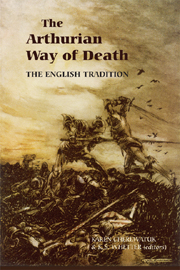Introduction
Published online by Cambridge University Press: 12 September 2012
Summary
‘Now tyde me dethe, tyde me lyff,’ seyde the kyng, ‘now I se [Mordred] yondir alone, he shall never ascape myne hondes!’ … Than the kynge gate his speare in bothe hys hondis, and ran towarde sir Mordred, cryyng and saying, ‘Traytoure, now ys thy dethe-day com!’
Thus Sir Thomas Malory prefaces his version of the final battle between King Arthur and Mordred at the climax of his late fifteenth-century Le Morte Darthur. Arthur's words, actions, and attitude, especially his privileging of right and revenge over personal safety, indicate the force of heroic motivation and its costs in Malory's Arthuriad. This combination of heroism and its fatal consequences makes Malory's Arthuriad more poignant than many of his sources. Malory's version of the final battle also displays Malory's own artistry and the nature of medieval storytelling and originality, for Malory inherited the outline of the narrative from his French and English sources, but felt free to treat this and other scenes according to his own artistic vision. As Fanni Bogdanow observes,
In reshaping the story of Arthur's death, Malory is continuing in the tradition of earlier writers, each of whom had modified and reinterpreted the version of his predecessors in order to convey his own particular vision of the rise and fall of the Arthurian kingdom.
At the same time, Malory's aphoristic sentiment suggests a truth at the heart of the Arthurian myth, that death is the king's lot, awaiting him as it does everyone else, both in the Arthuriad and in life.
- Type
- Chapter
- Information
- The Arthurian Way of DeathThe English Tradition, pp. 1 - 14Publisher: Boydell & BrewerPrint publication year: 2009



